P.C. Zick's Blog
August 26, 2025
BREWERY TRAIL – BLUE MOUNTAIN BREWERY

One of our favorite pastimes? Visiting craft breweries close to and far from home. Since we once homebrewed, we’re fascinated by what these local folks can do. Many of them began as living room brewers before expanding.
When we visited Waynesboro, Virginia, this past summer, we stumbled upon one of the more unique establishments and Virginia’s first rural brewery.
Photo by P.C. Zick – The bar at Blue Mountain Brewery in Afton, VA
Located just a few miles from where the Skyline Drive in Shenandoah National Park ends and the Blue Ridge Parkway begins, Blue Mountain Brewery provided us with a lovely summer evening of excellent food and superb craft beers. The sun was blazing hot when we arrived, so we opted to eat at the bar inside and enjoy one of the brewery’s IPAs–both hoppy and flavorful.
Afterwards, we took a couple of different samplings out to the large deck and yard area and discovered they grow their own hops! Their website states, they craft “real American beer inspired by thousands of years of tradition but not limited by convention.”
It shows in the four different taps we tried.
Photo by P.C. Zick – The hops grow in the shadows of the Appalachian chain of mountains at Blue Mountain Brewery


We sat in Adirondack chairs in the yard and watched folks play cornhole. The clouds played peek-a-boo with the setting sun.
And as they’ve done for millions of years, the Shenandoah and Blue Ridge Mountains oversaw yet another day settling over the lush valley of Virginia.
Photo by P.C. Zick – View of the mountains from the yard at Blue Mountain Brewery.
Visit Blue Mountain Brewery in Afton, Virginia –
9519 Critzers Shop Road Afton, Virginia
Monday – Saturdays: 11-10pm / Sunday: 11-9pm
August 19, 2025
FALLING IN LOVE WITH PITTSBURGH
I fell in love twice during the summer of 2009. The first time I fell in love with the man who would become my husband. The second time I fell in love with Pittsburgh, the city he had called home for more than three decades.

“You’re moving where?” family and friends asked when I announced not only that I was getting married but also moving away from Florida where I had lived for three decades. I had moved from Michigan in 1980 to Florida and swore I’d never go back to the north to live. Then suddenly I made my announcement—not only that I was moving north, but I was also moving to Pittsburgh? Few folks understood.
Photo by P.C. Zick – In the Strip District of Pittsburgh
The love part they understood, but they marveled that I had fallen in love with an industrial city known for its coal dust and factories. I admit, I also thought it strange, but I quickly discovered that Pittsburgh was a well-kept secret from most of the country as I explored its landscape and culture and met its people.
In all fairness, I had been fascinated by the geography of Pittsburgh since college in Michigan. It stuck out to me in a otherwise boring geography class as I learned about the Allegheny and Monongahela rivers converging to form the mighty Ohio, giving Pittsburgh a starring role in the Industrial Revolution of this country.
The idea of water creating our urban centers left an impression. Then I never thought much about Pittsburgh until 2009, when love brought me to visit the city for the first time.
The landscape of the Pittsburgh area surprised me. When I drove into the city from the airport for the first time, I marveled at the hills and the valley below carved out by the three rivers of Pittsburgh.
Photo by P.C. Zick – Looking up at hills above Ohio River in downtown

Soon after I moved to the Steel City, the Pittsburgh Post-Gazette reported folks had volunteered to paint planters downtown to freshen up for spring. No wonder Pittsburgh could reinvent itself from a coal and steel town filled with dirty skies to the gem it is today. The residents made it possible because they passionately love the city and all it represents. It uniquely exists as a gateway to the rest of the county and has been called the western East, the eastern West, the southern North and the northern South of the United States.
Places of green still exist here because the hills make some sections uninhabitable, both surprising and delighting me. I am an urban country girl, and I have always wanted it both ways. During the five years I lived there, I found balance in both my surroundings and in my personal life.
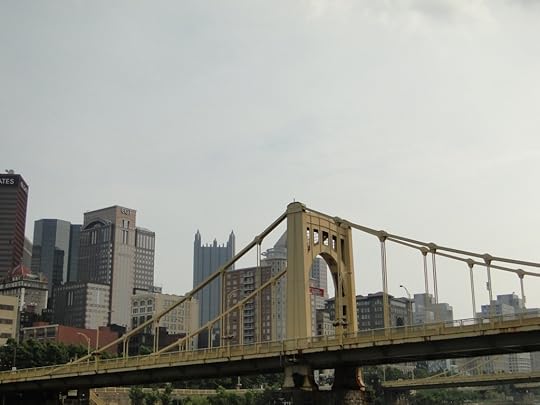
I loved the hills, but I also loved the architecture of the churches, commercial buildings, and homes. Studying those structures is a lesson in American history all by itself. The bridges are also a wonder of engineering and architecture. Pittsburgh, known as the “City of Bridges,” with 446 total has more bridges than any other city in the world, including Venice.
Photo by P.C. Zick – From the Allegheny River one of three identical bridges named after Pittsburgh icons – Roberto Clemente, Andy Warhol, and Rachel Carson
My love affair intensified after a visit to the Heinz History Center. I found myself curiously emotional as I learned about the people who could claim the area as home. Many influential folks from Pittsburgh played an important role in my life. Dr. Benjamin Spock taught me I would not spoil my child by picking her up when she cried, and Mr. Rogers visited our neighborhood every day to reinforce the concepts of friendship and citizenship in my young daughter. A statute of Fred Rogers complete with a red sweater looks out over the three rivers from what will forever be Heinz Field to those who love the Steelers passionately.
Jonas Salk erased the fear of polio during my childhood. And food stuffs I’ve eaten most of my life from Heinz to Delmonte originated in Pittsburgh.
Rachel Carson, whose environmental writing helped develop awareness of DDT and the pollutants in the air, began her life and education in a Pittsburgh still coughing from the fumes of coal-burning plants. She inspires me in my writing and life to this day. One of the first female journalists Nellie Bly broke through glass ceilings allowing me privileges unknown to the women of her generation.
Stephen Foster immortalized the place I lived in Florida for nearly three decades through song. He never visited “way down upon the Suwannee River,” but he called Pittsburgh home.
And Andy Warhol left Pittsburgh as soon as he could, but the city still claims the artist as a native son. An impressive museum and a bridge over the Allegheny—one of the three sister bridges named for Roberto Clemento, Warhol, and Rachel Carson—named for him grace the downtown area near PNC Park, home of the Pirates. He showed me that being different could be mind-expanding.

Although I did not know it at the time, Pittsburgh and its people served as the backdrop to my life, from the ketchup I poured on my burgers to the polio shot I received as a child. No wonder I fell hard for this place of steel with its soft edges and open arms.
Photo by P.C. Zick – Steelers at Heinz Field before its name was changed to Acrisure Stadium
Approaching downtown from the west, there is no view of a skyline. A mile from the city center all that’s visible are hills and signs announcing the approach of the Fort Pitt Tunnel. The tunnel, nearly a mile long, cuts through the rock of the hillside. Lights within its confines guide the way until daylight can be seen at the end.
Photo by P.C. Zick – Fort Pitt Tunnel from downtown


Suddenly, vehicles burst into the sunshine, and the highway crosses the Monongahela River. The sights of downtown—two stadiums, the Point, and all the skyscrapers appear showing a city in its finest glory with the Ohio River to the left and the Allegheny River straight ahead, and a distinctive skyline of steel and glass. I was a goner the first time I came out of the tunnel into the sunshine sparkling on the water.
Photo by P.C. Zick – Point State Park
Even though I moved away ten years ago, we still visit, and I am still in love. Once I fell in love, I also became a fan of the Steelers, Pirates, and Penguins, a requirement! We’ve traveled the country over the years, and on Sundays during the football season, we’ve always managed to find a Steelers bar from San Antonio to Myrtle Beach; Sedona to Charleston; Tallahassee to San Francisco. And every summer when we return, a visit to PNC Park to watch the Pirates mostly lose is a must-do event.
Photo by P.C. Zick – PNC Park


Go Steelers!
Photo by P.C. Zick – Watching the Steelers play while visiting Charleston, South Caroline in 2024.
August 12, 2025
OUR URBAN OASIS
 Piney Z Lake, Tallahassee, Florida
Piney Z Lake, Tallahassee, FloridaWe live on the southeast side of Tallahassee, but when we drive a mile from our home to a city park, it’s hard to believe we’re so close to an urban area with a population of 200,000. We call it Piney Z after the name of one of the lakes and the neighborhood bordering it, but its official title is Lafayette Lake Heritage Trail—trails for feet, bikes, and paddles.
At one time, the entire area was a swamp-like lake, but in the mid-twentieth century it became the custom in Florida to manipulate water, and Lake Lafayette was divided into three different bodies of water. The northern region is mostly swampland joining two city parks. The middle lake, Piney Z, is the one most used by residents such as my husband and me. The lower region is overgrown with invasive plants, but a canoe trail is visible.
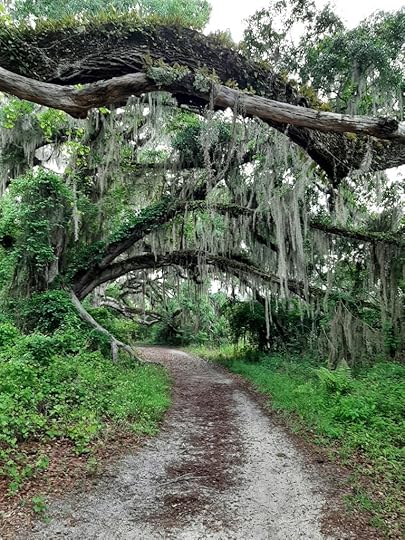 Spanish moss drips from the live oak trees on Bill’s Trail
Spanish moss drips from the live oak trees on Bill’s TrailWe hike the trail which is part dirt—some parts filled with roots but overhung with live oak trees dripping in Spanish moss. The middle section of the three-mile loop, contains a bridge over railroad tracks and a boardwalk overlooking the entire lake, which is dotted with cypress trees. The final stretch is a wide dirt trail with water on one side and a tree-filled hill on the other. Fingers of land—seven around the entire lake—go out onto Piney Z, a perfect isolated place for fishermen or wood storks and great blue herons. The hike takes about an hour, and it’s a peaceful calming exercise so close to home.

We also kayak the lake. It’s about a mile from the primitive boat launch to the land bridge separating Piney Z from the lower portion where kayakers or canoers can portage and take the canoe trail for another six miles. We mostly stay on Piney Z paddling the perimeter or just going to a stand of cypress and hang out and watch the birds. We try not to disturb the osprey nest above if the birds are in residence.
Despite man’s manipulation, this little oasis of green in Florida’s capital city sustains our spirit while filling our senses.
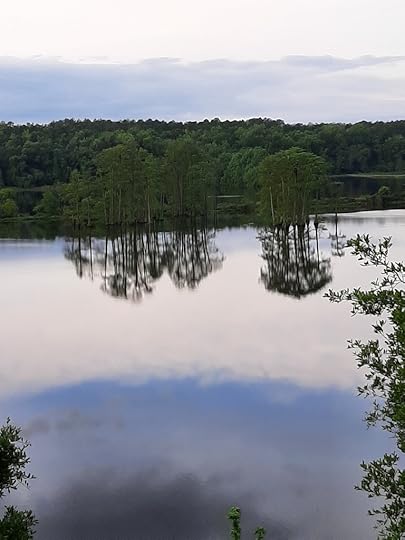 Cypress trees on Piney Z Lake
Cypress trees on Piney Z Lake
August 5, 2025
ACADIA NATIONAL PARK – COASTAL MAINE
By P.C. Zick @pczick.bsky.social
“Are you going to Acadia?”
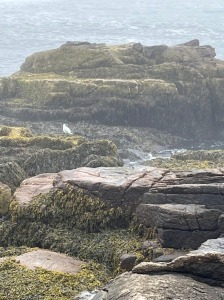 Photo by P.C. Zick – Thunder Hole, Acadia National Park
Photo by P.C. Zick – Thunder Hole, Acadia National ParkThis question popped up at first mention of our impending trip to Maine. If it hadn’t been on the Road Scholar agenda, we might have had to cancel because any other answer, “but of course” would not satisfy the askers of the question.
I understand the question now that I’ve been there myself. It will be the first thing I ask whenever anyone mentions traveling to the unique and inspiring state of Maine. We stayed in Bar Harbour, which is located on the northeast corner of Mount Desert Island and within rock throwing distance of Acadia National Park. The island consists of two lobes and is considered more of a fjord than anything else. The national park covers 47,000 acres of the island, but much of it is in sections because of how it became a national park back in 1919.
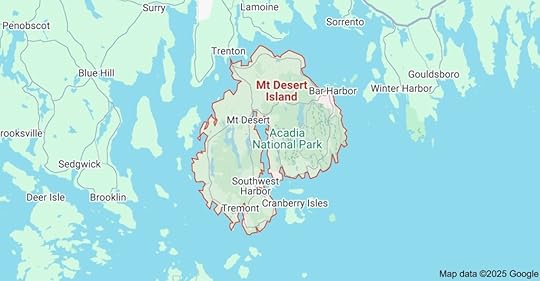
Until the 1840s, residents of Mount Desert Island consisted of native tribes the Maliseet, Micmac, Passamaquoddy and Penobscot, known collectively as Wabaanaki—”people of the dawnland”—and the occasional white fishermen and boat builders.
Photo by P.C. Zick – coastline of Mount Desert Island

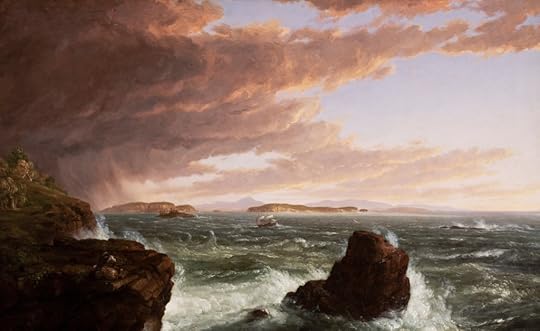
When Hudson River School painter, Thomas Cole, began capturing the island on canvass with his New York City patrons, things began to change on the remote and isolated glacially created granite coastline. The Gilded Age industrialists found Bar Harbour on Mount Desert Island the perfect place to build their “cottages,” an odd misnomer for the mansions built on the granite cliffs of the island shaped like a fjord.
Photo painting by Thomas Cole after a squall off coast of Acadia National Park.
The likes of Rockefeller, Carnegie, and Vanderbilt saw the threat of continued development on the natural beauty of the place and began buying up large tracts of land, which in turn, they donated to the government for preservation. By 1919, the United States had designated the area as Lafayette National Park—later renamed to Acadia in 1929—the first national park east of the Mississippi. The map of the park shows the distinct parcels donated, which form much of the island into a national park.

Our tour bus driver—a mastery of mountain roads in our rock-star-like ride—drove us around the Loop Road with stops at Thunder Hole, Jordan Pond, and Cadillac Mountain. Unfortunately, the day was foggy so views were non-existent on Cadillac Mountain—the highest point on the eastern seaboard. But we had a lovely stop at Thunder Hole, so named because of the “thunder” sound made when the waves come in a long and narrow alley in the rock and pound against granite as it hits shore. Quite a beautiful sight made even more magical by the weather conditions.
Photo by P.C. Zick – Thunder Hole, Acadia National Park
Mainers have their own way of doing things we learned on our coastal journey. Case in point: I kept going back to the maps and tour guides to check the spelling of Mount Desert Island because all our guides kept calling it Mount “Dessert” Island. I later learned that Mainers pronounce “desert” as “dessert,” but I never learned why except that I had learned enough to know that they prefer it that way, and so it goes in Maine.
Photo by P.C. Zick – Black Guillemots (cousin to the Atlantic Puffin) in the Atlantic Ocean off the coast of Acadia National Park

For more information, visit the National Park Service website for Acadia National Park.
July 29, 2025
NEVER IGNORE A “LITTLE OLD LADY IN TENNIS SHOES”
By P.C. Zick – @pczick.bsky.social

“I’m just a little old lady in tennis shoes.” So said Margaret Hames when other more glowing titles followed her name.
Environmentalist, conservationist, defender of wetlands, scrubs, and hammocks, and savior of public places in Brevard County, Florida, are more accurate descriptions of this “force of nature,” her daughter, Pat Baxter, said recently.
Photo of Margaret Hames hanging in the nature center that bears her name
Her life took some unusual twists and turns despite following the traditional role of wife and mother for many years–it was the choice she made back in 1943 when she married her childhood sweetheart William Hames. She was born in 1921 in Georgia, where I would imagine young girls weren’t raised to be mavericks, but despite that, she graduated from Agnes Scott College in 1942 with degrees in chemistry and zoology. She was offered a fellowship to Emory University in biochemistry, which involved working on the Manhattan Project in Los Alamos, New Mexico, where, in 1942, top-secret work with the most elite scientists of the time raced to create the atomic bomb used in 1945 to end the Pacific portion of World War II.
She turned down the offer. Instead, she married William in 1943 and soon thereafter began raising their family of three children. It wasn’t until 1966 that she pursued a career as a science teacher at Lyndon B. Johnson Junior High School in Eau Gallie, Florida. She taught for eleven years.
When she retired, she put her love of nature into overdrive and taught herself everything she could about the native plant species of Florida.
“It’s sad that everyone is so busy remaking Florida, they can’t enjoy it for its own identity,” Margaret said in one of the many articles written about her. “We should be proud and capitalize on what Florida is instead of trying to change it into something it isn’t.”
In 1985, she became the director of Florida’s Native Plant Society and worked tirelessly to keep out the nonnative invasives, particularly, the “terrible three”: Brazilian pepper, Australian pine, and melaleuca. She created mini-ecosystems in her backyard in Melbourne Village in Brevard County, which included pineland, hammock, and wetland areas.
She stood down bulldozers to protect pristine dune systems, battled developers and elected officials to protect and save the natural world of Brevard County. She also worked to protect the endangered scrub jay and its habitat. She loved plants and wildlife alike. In 1996, Florida Environments magazine named her Person of the Year.
Many of the natural areas in and around Brevard County exist today because of her tireless work, including the Enchanted Forest in Titusville.
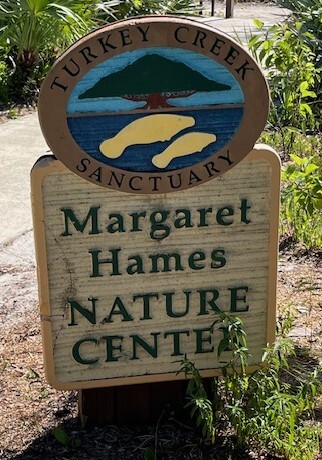
Turkey Creek Sanctuary Preserve in Melbourne is the home to the Margaret Hames Nature Center, an interpretive center created in 1992 to honor the legend and savior of so many natural areas in one of the most overdeveloped in the country.
Her philosophy on the environment sums up her legacy better than I can in my little post.
“We are not the owners of the land, but the stewards. We owe it to future generations to use the land–plants, air, water, animals–properly.”
Her life work from scientist to wife to mother to teacher to environmental crusader shines as inspiration to me. It is never too late in life to make a difference in the world. Never forget a little “old lady in tennis shoes” can make a difference.
Check out the three books in my Florida Fiction Series. Each book stands alone but each of them shows how individuals work together to save Florida’s fragile environment.
All three are available on Kindle (free with Kindle Unlimited), paperback, and audio. Click below to see all the options.
grab your copies of the books in the Florida fiction series
July 22, 2025
LIGHTHOUSE PASSION SERIES – MORRIS ISLAND, CHARLESTON
By P.C. Zick – @pczick.bsky.social
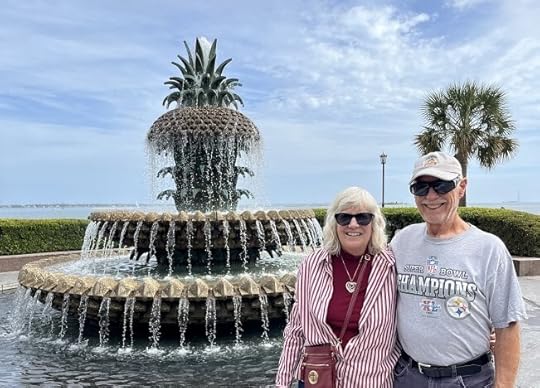
On a recent trip to Charleston, South Carolina, we kept hearing about the charming town of Folly Beach a short drive south of Charleston proper.
Photo: Pineapple Fountain, Waterfront Park, Charleston, SC
A colorful little beach community with the second longest boardwalk on the eastern coast, the Folly Beach Pier juts out into the Atlantic Ocean for 1,000 feet. Surfers float and catch a wave on both sides. The town itself is filled with fun-inspired stores and restaurants, such as Rita’s where we had breakfast just steps from the beach and pier.

It was during the breakfast out on the deck that we heard some of my favorite words, “Have you been to the Morris Island Lighthouse just down the road?” We hadn’t but as soon as the pier had been walked and the pancakes digested we headed down a beach road where we parked on the side of the road and walked through the sand to the beach.
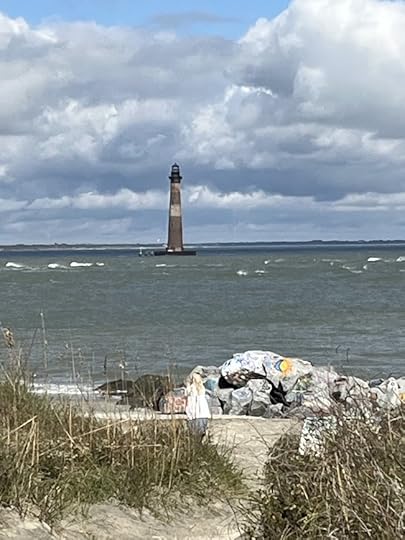
And there is was floating out on thee ocean on a concrete barrier all by itself. The Morris Island Lighthouse, completed in 1876, bobs in the water at the entrance to Charleston Harbor. Ironically, its original goal was to guide ships safely in or around the harbor, but its very location put it at risk. It mostly survived a cyclone in 1885 only to have an earthquake crack its 161-foot tower in 1886. But danger lurked int hee ferocious sea and beat at its door. Erosion brought it too close to the shore, so despite its being fully automated, in 1962, the light was extinguished.
Photo by P.C. Zick – Morris Island Lighthouse
Today, Save the Light, Inc. has a lease on Morris Island Lighthouse to preserve it. Occasionally, they still light is automated lens, and a ring of concrete encircles it to help keep it afloat.
It’s a sight to see, unlike its replacement, the Charleston Light, on Sullivan’s Island. I like the old style not the square black and white design of the current light guiding ships safely in and around Charleston Harbor.
Photo by P.C. Zick – Charleston Light, Sullivan’s Island
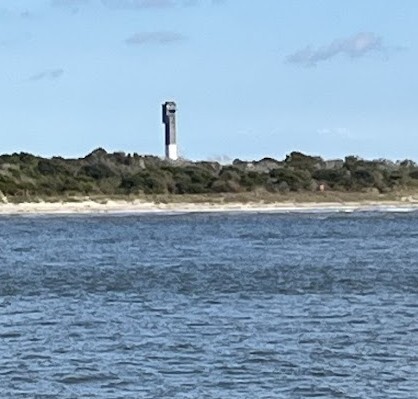
I’m glad it’s functional ‘cuz it sure ain’t pretty.

The Grateful Fates: A Novel of Friendship, Revenge, and Survival
by P.C. Zick
Four women. Four decades of friendship. Four twisted relationships.
Kindle, paperback audioJuly 15, 2025
WATCHING HOPE FADE FASTER THAN A HENNA TATTOO
By P.C. Zick – @pczick.bsky.social
In 2004, I took a solo trip to Morocco where a friend was assigned to the consulate in Casablanca. I traveled around the country on my own, but in Casablanca I was invited into the private homes of several of my friend’s co-workers. This journey left an indelible mark on me as language barriers forced me to observe. I wrote the following essay after a haunting afternoon on the inside of the walled home where the woman of the household hosted Saturday parties once a month for women only–including the musicians and henna artists hired to entertain.

Moroccan women know how to party. But it is not the partying brought on by alcohol or drugs.
When I attended a female-only Henna Party in Casablanca one Saturday afternoon in 2004, I learned freedom could be just as intoxicating as a bottle of wine.
Photo by P.C. Zick – The host (left) of a Woman’s Only Henna Party in Casablanca with my friend Soumaya
Women filtered into the house, bringing laughter and hugs and hope, as well as an abundance of food. A young woman entered the salon, and her presence brought a brightness to the party. I was drawn to her immediately because of her glow. She walked over to where I sat with my friend, Soumaya, on the long banquette on the back wall of the salon. Soumaya knew this girl, and they double kissed on the cheeks and embraced.
Then Soumaya said, “This is Patricia from America.”
The girl leaned down and double kissed my cheeks, a gesture of friendship and familiarity. When she straightened, she offered me the most brilliant smile, welcoming me into this private world of Moroccan women. She and Soumaya spoke excitedly in Arabic so the conversation was lost to me. It was clear that Soumaya felt great affection for this beautiful woman who appeared to be no more than twenty.
She wore jeans and a T-shirt, and her light brown hair glowed in the soft afternoon light permeating the room. Her brown eyes sparkled, and her smile put me at ease.
Traditional Berber music filled the room as female musicians sitting at the end of the salon, left their cigarettes and mint tea on the low table, and performed for the other women.
Photo by P.C. Zick – Female musicians performing traditional music


I lost track of the girl as the party swelled around me. Over forty women eventually crowded into the entrance room and the salon beyond. Drums and stringed instruments were at first nearly drowned out in the wailing sounds of the singers, who echoed or answered one another. Several songs later some of the women began to clap and then a faster beat took precedence. A woman in a black and cream-colored gown made a whirring sound with her tongue inside her mouth and soon everyone jumped up and began to dance. Arms were raised in the air while nothing else on their body moved except below the waist. The hands waved slowly and fingers snapped together in beat with the drums.
Photo by P.C. Zick
As the henna artist painted my ankles another friend asked me, “See that girl over there? The one wearing the turquoise gown?”
“Yes, she’s beautiful, isn’t she?” The beautiful young woman I had met earlier had changed into the traditional dress of Morocco.
Photo by Linda Turner – My ankle tattoo

“That’s a sad story.” My friend shook her head. “She’s twenty-nine.”
And then she proceeded to tell me the rest of the tale. While she was still a teenager, the girl’s mother died, leaving her to raise her younger brothers. Then just a few years ago, her father died, leaving her a single female in an Arab country. She had no choice but to go live with her older brother who was married with a family.
“He treats her like a slave,” my friend continued. “She takes care of his household and is not allowed to leave the house except to come to these parties. This is her one day of freedom.”

I watched the woman who I had thought was a decade younger than she really was. She danced with her friends and threw back her head and laughed with a great belly full of joy when one of the women jumped up on the table to boisterously grind her hips. I suddenly understood that these parties served the purpose of providing hope in a life where living under the restraints of another weighed wearily on the soul.
Photo by P.C. Zick – Table dancing as young woman watches with joy
For a few hours on a Saturday at least this one young woman could escape her jailer and live. I wondered how many others lived the same type of life. If the frenzy around me accounted for anything, it might mean almost all the women present had escaped the tyranny of their oppressors, whatever or whoever they were, for a short time. As much as I wanted to despise her brother, I realized he is simply following the traditions of his culture. As the family’s patriarch, it was his duty to protect the honor of his sister because she was of an age where her virginity was doubted. Perhaps it was this fear that made him even stricter with this beautiful woman.
Near the end of the party, the young beauty stood in the middle of the room, watching the others dance. I recognized her even though her back is to me. The turquoise of her caftan had not faded as the lights in the living room appeared and the night closed in around the hidden house in Casablanca.
Then she turned toward me, and I almost did not recognize the person standing there. She no longer smiled and the glow from her eyes had dulled, creating a haunted and hunted quality in those brown orbs. Cinderella was disappearing, and I expected her gown to fall in tatters at her feet as she reentered the reality of her life once again.
She aged as I continued to watch her, and I tried to imagine the thoughts invading her mind as hope walked out of her life and the hour when she would return to her prison neared. She gained the decade I had subtracted from her age earlier in the day, and the curves of her mouth stayed downward not so much as in a frown but as in resignation. Her hair hung in lifeless strings around her face, and she stared straight ahead, no longer participating in the activity swirling around her as the guests made their good-byes. And I watched as another decade laid itself upon her visage and hope slammed the door in front of her. The henna designs on my ankles will fade away long before she has another opportunity to enjoy hope for a few short hours.
I watched as the visible signs of hope faded from the face of a beautiful young woman, turning her glowing eyes into dying embers and her smooth skin into ashen lines lacking any type of anticipation.

Check out my memoir of my travels during the most tumultuous decade of my life as I journey to Morocco to Italy to Panama and then down Route 66.
Odyssey to Myself provides insight into the importance of travel to help heal.
available in ebook and paperback on all major online retail sitesJuly 8, 2025
SMALL TOWNS ROCK – GRAFTON AND PHILIPPI, WEST VIRGINIA
Photo: On the dam trail in Tygart Lake State Park
By P.C. Zick – @pczick.bsky.social
We stumbled upon a unique area in West Virginia. Each year we visit family in Blacksburg, Virginia, and Pittsburgh, Pennsylvania. The three hundred miles between them takes us through West Virginia and the New River Gorge, which we’ve visited several times on our trips. Last August, I found another spot, still in West Virginia, at Tygart Lake State Park outside of Grafton, West Virginia.
When we reached Grafton, we were stopped by one of the longest and slowest trains I’ve ever encountered. Mostly empty coal cars on the way to pick up their loads. We waited for ten minutes hopeful to see a caboose eventually. Then the slowest train in the world stopped—no caboose or engine in sight. When nothing seemed to be happening, I made an executive decision and turned our car around and headed almost in the direction where the park lay. GPS would reroute and catch up, which it did almost immediately, and we were treated to a lovely drive through the mountains of western West Virginia. On subsequent trips to sightsee, we took the same exact route.

Grafton lies in the heart of coal country and the placement of the Baltimore and Ohio railway for access to the Ohio River in Wheeling led to the creation of a booming railroad town by 1852 when the line was completed.
Photo courtesy Canva
Lodging at the park consists of the usual camping sites, cabins, and rooms in the main lodge. We opted to stay in the lodge where our room opened to views of Tygart Lake with trails leading to the dam that formed it from the Tygart Valley River. The lodge itself had a lovely dining room and deck with perfect views of the lake and hills surrounding it.
Photo by P.C. Zick – View of the lodge from lake
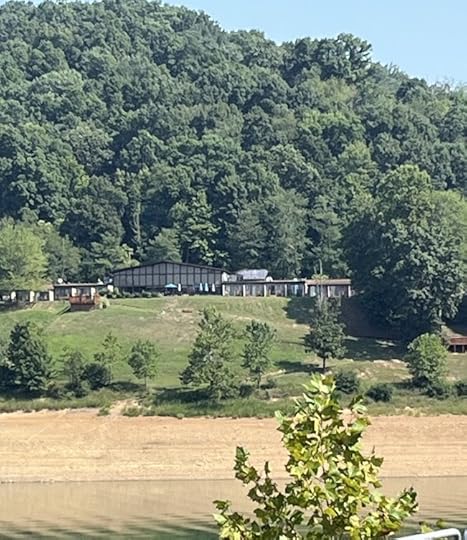
 Photo by P.C. Zick – View from our room in the lodge
Photo by P.C. Zick – View from our room in the lodge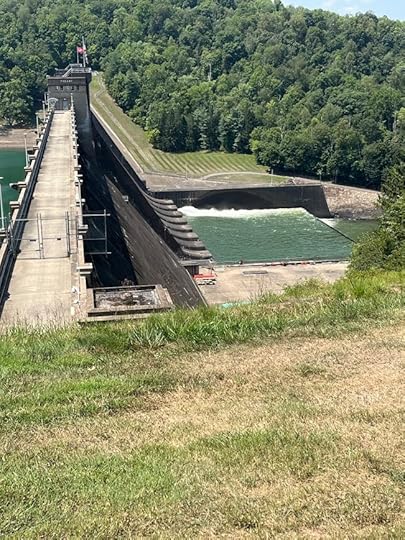
The dam, built in 1938 by the Army Corps of Engineers for the Pittsburgh District assists the area with flood control and water conservation.
Photo by P.C. Zick – Tygart Dam Spillway – Length 1,921′ – Height 230′
On one of our day trips, we knew we had to visit the small town of Philippi nearby because it boasted one of the few remaining covered bridges in the country. Built in 1852, the bridge allowed the turnpike—now U.S. Route 250—to cross the Tygart Valley River and head to Fairmont, West Virginia. It is considered a masterpiece and today much of the original structure still stands and continues to offer passage over the river.
Photo by P.C. Zick – Philippa Covered Bridge

 Photo by P.C. Zick – Inside the bridge that has been standing since 1852 and survived the first land skirmish of the Civil War
Photo by P.C. Zick – Inside the bridge that has been standing since 1852 and survived the first land skirmish of the Civil WarWhen we arrived at a parking lot near the base of the river, we learned a surprising tidbit about that bridge. The Philippi Covered Bridge also witnessed the first notable land battle of the Civil War. Although minor in comparison to what happened later in the war, June 3, 1861, saw a skirmish based on one woman’s attempt to thwart a possible encounter between the two sides.
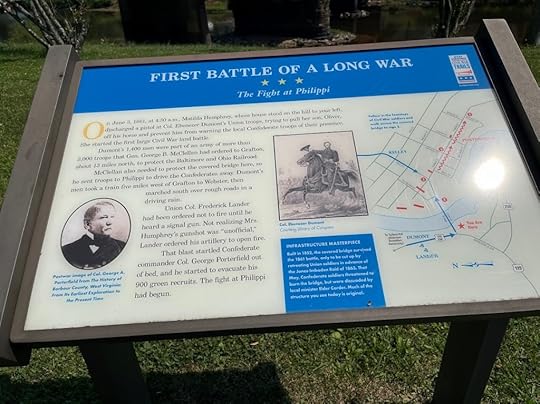 Photo by P.C. Zick – Marker at base of bridge
Photo by P.C. Zick – Marker at base of bridgeWord had come that 1,400 Union troops were headed to Grafton to protect the B&O Railroad and would soon be crossing the river at Philippi. One woman who lived on the hill above the bridge wanted to warn her son about the Union troops. She shot her pistol in the air to scare her son off his horse. Union Col. Frederick Lander had been told not to fire until he heard a signal gun, so when he heard the pistol, he ordered his artillery to open fire. The unprepared and green Confederate soldiers lost the battle overnight.
The Union soldiers were able to occupy the town for a brief time. There were few casualties, but the first amputation of the war did occur. And it catapulted Gen. George McClellan, who ordered the troops to Grafton, to national prominence. By July, he had been named commander of the Army of the Potomac.
Photo: Civil War Archives – Gen. George McClellan

Some of my best travel experiences occur when I allow the road to take me where it will instead of the other way around. The trip to western West Virginia showed me once again that history may be preserved in museums, but it lives where it happened.
 Photo by P.C. Zick – Enjoying a refreshment at the lodge
Photo by P.C. Zick – Enjoying a refreshment at the lodge after a day of sightseeing in Philippa
I’m always interested in stories about Gen. George McClellan, who eventually fell out of favor with President Lincoln. My great-grandfather, Harmon Camburn, wrote about his experiences during the Civil War as a soldier with Michigan’s 2nd Infantry. His regiment received a review by General McClellan and President Lincoln on October 29, 1861, at their camp along the Potomac.
All being in readiness, every man became perfectly motionless. Not a move could be seen. Not a sound broke the perfect stillness until General McClellan and his brilliantly mounted staff rode upon the field accompanied by President Lincoln and his suite. At this first sight of this glittering cavalcade, the cannons boomed a national salute. As soon as the deafening thunder died away, the President and the General, followed by all their train, rode around the valley in front of the line, and viewed the troops. As each successive division was reached, the drums rolled, flags dipped, and the soldiers presented arms. As soon as the circuit of the field had been made, the President and the General took their stand in a convenient position, and the troops passed in review before them. The Infantry moved in “double column closed en masse,” that is, one hundred men abreast with each succeeding rank as close to the preceding one as men can walk with freedom.
Despite McClellan’s removal after the Union’s disastrous Seven Days Battle in July 1862, the soldiers all held him in high esteem, or at least my great-grandfather did. When his first son, my great-uncle, was born in 1865, he named him George McClellan Camburn.
 Civil War Journal of a Union Soldier
Available on Kindle, Paperback, and Audio
Civil War Journal of a Union Soldier
Available on Kindle, Paperback, and Audio
July 1, 2025
ON THE ROAD – COASTAL MAINE AND ROAD SCHOLAR

“Let’s go somewhere we’ve never been,” I suggested nearly a year ago to my husband.
“I’ve never been to Maine,” he replied.
I had been to Maine once for fifteen minutes when I’d visited Portsmouth, New Hampshire, decades ago. We drove over the border to buy live Maine lobsters than went back to our campground in New Hampshire to cook them. So technically I hadn’t been either.
With a destination in mind, I began organizing a trip along the coast of Maine. Hotels, tours, car rental, plane fare, and access to Acadia National Park. It all seemed daunting and expensive. Then I remembered that several friends had been praising something called Road Scholar. A quick check found they had exactly what I’d been planning–coastal Maine from Portland to Bar Harbor. Perfect. And cost effective considering the number of meals and hotel stays and expert guides included. Best of all, I wouldn’t have to be in charge.
So we booked for June 14-20. Seven days of absorbing all this unique state has to offer.
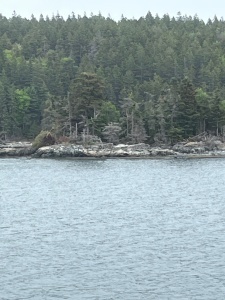 Coast of Maine – P.C. Zick
Coast of Maine – P.C. ZickHere are some surprising things I learned about Maine.
Its coastline is 50 miles longer than California because of the jagged edges of granite that make up the coast.It’s the only mainland state that touches only one other state, which is New Hampshire despite originally being a part of Massachusetts until 1823.Only state that consists of only one syllable.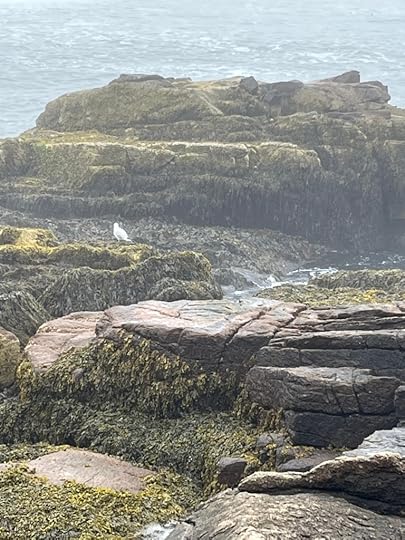
I’ll leave you today with some phots from the trip. I’ll write more about this fantastic journey in the near future.

June 24, 2025
DESSIE SMITH PRESCOTT – A WOMAN FOR THE AGES

As a freelance writer, I’ve been fortunate enough to write about some interesting events and people. In a few instances, I’ve even had the privilege of interviewing a handful of famous or infamous folks. Dessie Smith Prescott could be categorized as both famous and infamous, and the interview with her in 2001 remains a favorite. When I interviewed her in 2001 on her 95th birthday, she was the oldest living member of the Florida Women’s Hall of Fame. She died the following year. Her inspirational life story shows that the human spirit, despite the worst odds, can survive anything through hard work and dedication.
Photo by P.C. Zick at Dessie Smith Prescott’s 95th birthday celebration in 2001.
Born in 1906 in the wilderness of north Florida, Prescott survived several tragedies as a child. When she was three, her father was murdered.
“Daddy was a big man, and he was coming home,” she told me during her birthday celebration at her home on the Withlacoochee River, near Crystal River, Florida. “They didn’t have streetlights, and somebody waylaid him and took him across the head with a big healthy post.”
In 1918, her two brothers were in New York awaiting departure to fight in the war. Her mother wanted to see her sons before they left, so Prescott and her mother left Florida to visit them in New York, but while there, her mother died from the Spanish flu.
“Mama expressed a wish to be buried in Florida,” Prescott explained. “So, at twelve years old I said, ‘I’ll taker her back home.’ And I did.”
It took Prescott three days on the train to bring her mother’s body back to their home in Island Grove, near Gainesville, Florida. “So, she was buried where she wanted to be.” Prescott smiled broadly.
Upon her return to Florida, she moved in with her aunt and uncle near Sparr but only stayed a few years. She headed first to Baltimore to live with her brother but soon left for Atlantic City where she lied about her age to land a waitressing job on the boardwalk. When she was seventeen, she had saved enough money to return to Florida. She found a strip of land near Citra that she liked, so she found the owner and approached him with the deed and a hundred-dollar bill.
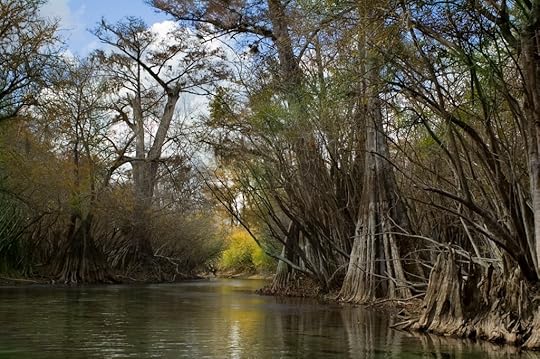
With determination, she set out to build a cypress log cabin herself on her newly acquired land. She found a mill owner who would cut the logs for free if she went into the cypress swamp and marked the ones she wanted. An old man with three oxen helped her pull the logs out. In three years, she finished the house with two great rooms, a kitchen, dining room, three bedrooms, a bathroom, and two fireplaces. Thus, by the age of twenty she owned sixty acres with a large log cabin. Prescott lived for adventure and did not let the standards of society shackle her to the traditional female role.
Photo by P.C. Zick – Cypress trees in north Florida
She told me she married her first husband while building the log cabin, but she can’t remember exactly when. “I guess I’d run out on him at some point,” she said in 2001. In fact, Prescott married six times, with the sixth marriage lasting twenty-six years, and the only marriage to make her a widow. She didn’t stay married if, “I decided the person didn’t fit in with my life. I decided the best thing to do was to give them their freedom. I paid for all my divorces. I enjoyed them all for a time.”
Prescott became friends with another famous woman in the Florida Women’s Hall of Fame—Marjorie Kinnan Rawlings, who had settled in Cross Creek not far from Prescott’s home.
Photo: Marjorie Kinnan Rawlings on the porch of her home in Cross Creek.

Prescott met Rawlings after a neighbor came to the rugged outdoorswoman and asked her to visit a new couple who had recently moved onto an orange grove near Cross Creek. Prescott’s friend predicted that without help the Rawlings might starve to death.
“The grove had been neglected for years,” Prescott said. “Groves take about twice as long to bring back as you’ve neglected them, and they hadn’t got a chicken or pig or anything on the whole place.”
So Prescott visited the house in Cross Creek where Rawlings wrote her Pulitzer-prize winning novel The Yearling. After she assessed the couples’ dire situation, she took Marjorie under her wing. Despite being ten years younger than Rawlings, Prescott took to calling her “young un” because “she didn’t know anything about anything that I did.”
When Rawlings’ marriage began falling apart, Prescott suggested the two take a trip on the St. Johns River from its beginnings in Volusia County up to the Ocklawaha River.
Rawlings chronicled the trip in the essay “Hyacinth Drift,” which was published in Cross Creek. She wrote, “Once I lost touch with the Creek …I talked morosely with my friend Dessie. I do not think she understood my torment, for she is simple and direct and completely adjusted to all living. She knew only that a friend was in trouble.”
Photo: Hyacinth

Prescott summed up the differences between the two women in an interview with Florida Magazine in 1995. “I always said Marge could describe a magnolia, and I could smell it. She was that good.”
During the trip, Prescott and Rawlings encountered men who were amazed at the audacity of two women traveling the river without accompaniment, but the two women paid little attention. They came upon the port in Sanford on a Sunday morning, and Prescott prepared for the place where large-vessel traffic on the St. Johns stopped.
Rawlings wrote, “Dess strapped around her waist the leather belt that held her Bowie knife at one hip and her revolver at the other and felt better prepared for Sanford than if we had been clean.”
 Dessie signed “Hyacinth Drift” in my Cross Creek book when I interviewed her in 2001.
Dessie signed “Hyacinth Drift” in my Cross Creek book when I interviewed her in 2001.The two women drew apart by 1936. According to Rawlings’s biography by Ann McCutchan, The Life She Wished to Live, Rawlings pulled away from Prescott. McCutchan said that fifty years later Prescott blamed it on “Marjorie’s drinking, depressive moods, and refusal to testify in Dessie’s divorce trial,” although Prescott couldn’t remember which divorce it might have been. In 1943, they must have smoothed the rough spots. Prescott had joined the Women’s Army Corp during World War II and showed up at the house in Cross Creek with five other WACs. McCutchan notes that Rawlings wrote, they were “a tough bunch of pistol-packing Mamas.”
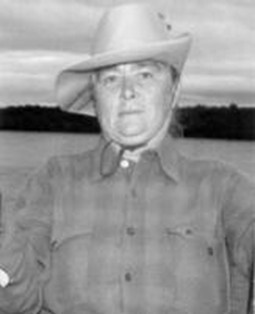
Prescott worked almost her entire life. She learned to fish and hunt when she was five to put food on the table. She waitressed, she herded turkeys, worked in real estate in Tampa and Orlando, sold cars, and did a myriad of other odd jobs that suited her. Her place in the history of Florida women is sealed in her accomplishments. She was the first Florida woman to become a licensed fishing and hunting guide as she led fishing and hunting parties into the wilderness in Florida, Alaska, and Africa. She became a pilot during World War II, which made her Florida’s first licensed female pilot.
Photo: Dessie Prescott Smith
Named for the Russian town of Odessa where her uncle had fallen in love with a Russian girl, Dessie’s legacy remains as unique and beautiful as her name.
A recent biography of Dessie Smith Prescott with lots of photos and shared memories of those who knew her best, chronicles her life and provides some insight to her simple yet expansive life.
Dessie Smith Prescott by Kevin McCarthy
Paperback only
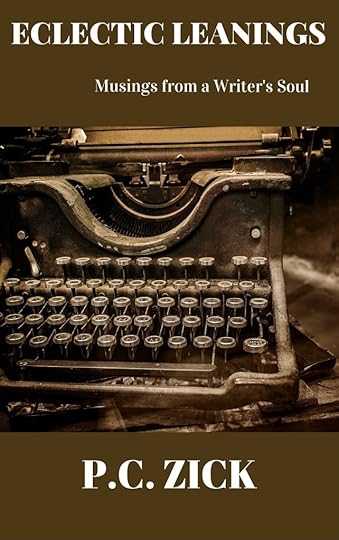
To read more interviews and essays by P.C. Zick, check out Eclectic Leanings – Musing from a Writer’s Soul on Amazon (Kindle and Paperback).
buy eclectic leanings by p.c. zick


